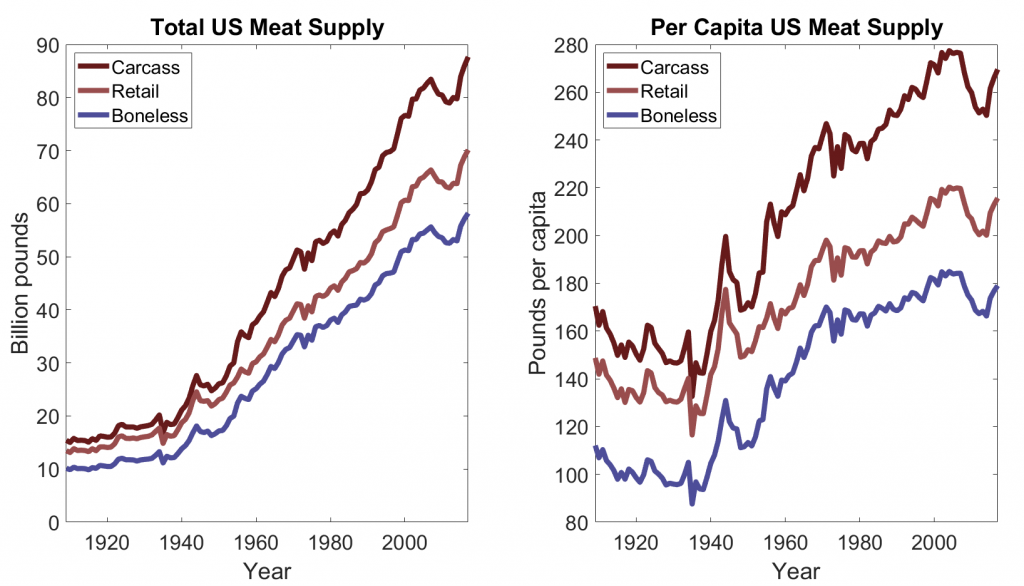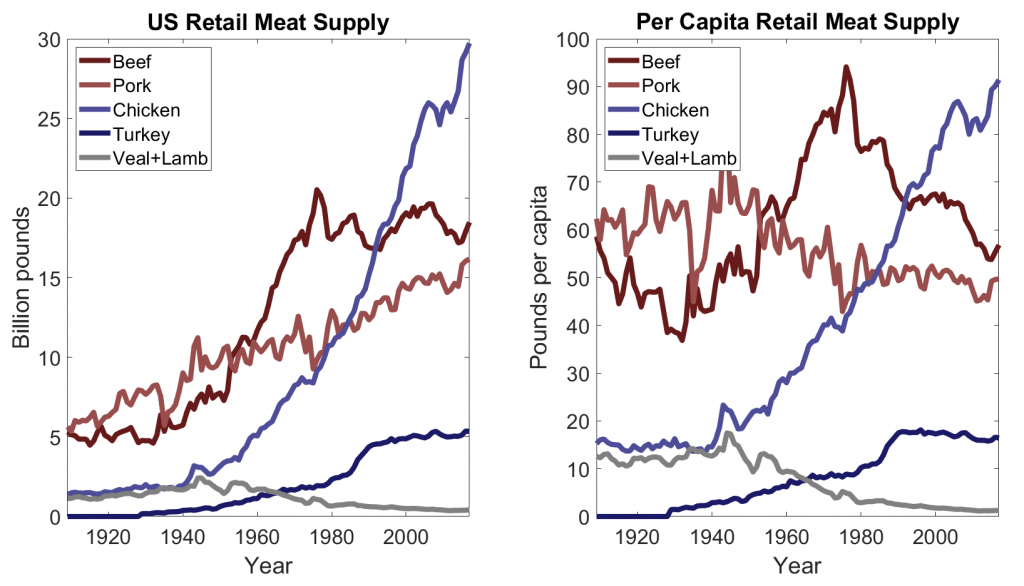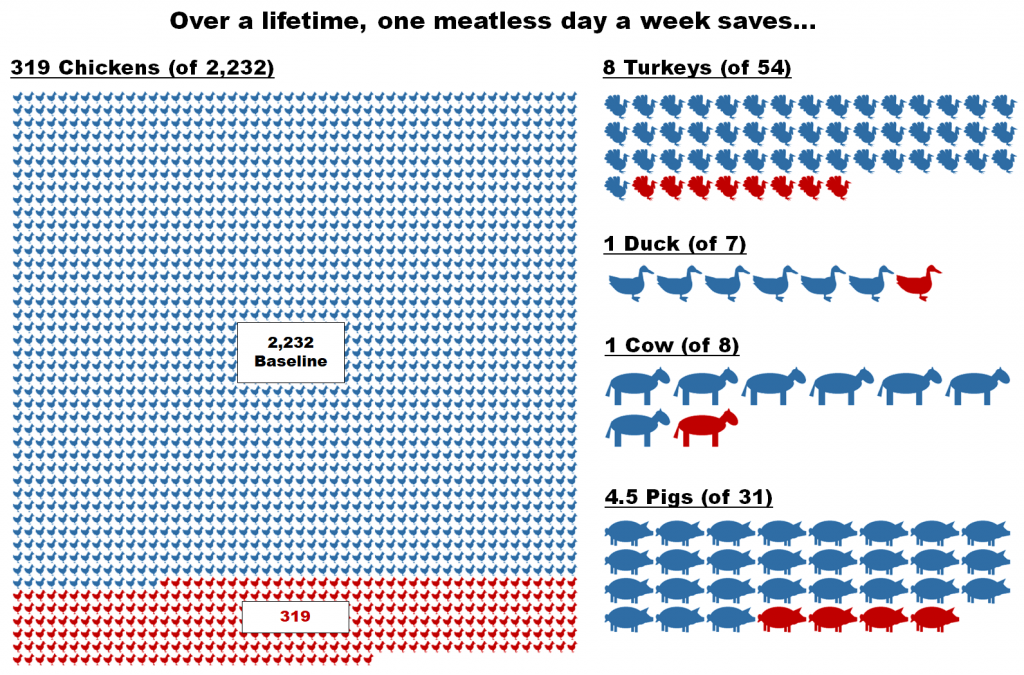How Many Animals Does The Average Person Eat In A Year
(Mail service as well published on medium.com!)
Vegetarian, vegan, plant-based, etc. diets seem much more mainstream in the media these days, and meat substitutes are no longer just a bad joke, and however the typical American eater is the greatest carnivore in all the world, with Americans consuming more meat and other animal products (per capita) than any other country. And meat consumption continues to climb, reaching tape highs every twelvemonth for the last five years, though this year the coronavirus may however put a minor paring in this trend.
So, just how much meat does the boilerplate American consume? Fortunately, the USDA provides plenty of data on carcass, retail, and boneless meat supply for over 100 years. Figures 1 and 2 summarize the trends from 1909 through 2017 (excluding seafood), and we can summarize things as follows:
- Since World State of war 2, a revolution in livestock, and peculiarly poultry production, has kept per capita meat consumption loftier, which is now over 220 lbs of retail meat per person per year.
- Chicken has overtaken beef equally the number one meat consumed in America, with an astronomical number of chickens now raised to slaughter yearly in solitude systems.
- The veal and lamb markets have largely collapsed in contempo decades.
- Not shown here, Americans as well each eat nearly sixteen pounds of seafood, with shrimp the biggest component at over 4 pounds. This represents on the gild of several ten billion fish and shellfish.
Meat Trends in the US

Figure 1. Trends in full meat consumption (excluding seafood) in the Us from 1909 through 2017. The left gives total meat supply, in terms of either total carcass, retail, or boneless weight, with like per capita trends on the correct. Annotation that this dataset ends at 2017, just meat consumption continued to climb in 2018 and 2019 as well. Data from the USDA Food Availability Data Arrangement.

Figure 2. Trends in yearly retail meat consumption for major animals in the US from 1909 through 2017. The left and correct give total and per capita consumption, respectively. Note peculiarly the explosion in chicken, which is now America'south favorite meat. Data from the USDA Food Availability Information System.
Something to notation here is the deviation between live weight, carcass weight, retail weight, and boneless weight, every bit the unsavory business of converting a living fauna to a retail production necessarily involves losses. Carcass weights are somewhere on the order of fifty–70% of live weights, while terminal boneless weight is in turn almost threescore% of carcass weight. These losses are only one reason eating animals is less efficient than plants: Non but do animals convert but a fraction of the energy and protein in their feed into biomass, only a fraction of that biomass is ultimately edible.
Meat Totals
And now, how many animals does it have to give us over seventy billion pounds of retail meat each twelvemonth? The USDA'south "Livestock Slaughter" and "Poultry Slaughter" reports paint a grim picture, with the following slaughter counts for 2019:
- 34.14 million cattle and calves
- 129.91 1000000 hogs
- ix.33 billion chickens
- 227.68 million turkeys
- 27.55 million ducks
- 3.05 million sheep, goats, and bison
- Sums to 9.75 billion total farm animals
Thus, almost x billion farm animals meet their stop each year to feed American appetites, with the unfortunate chicken representing but over 95% of this total. This is unsurprising considering chickens reach slaughter weight in simply six weeks and weigh a chip over half dozen pounds at slaughter, while cattle, for example, take around two years and weigh one,350 lbs at slaughter. At present, divide by the US population and nosotros go far at most xxx farm animals per American per twelvemonth, with 28 of these chickens; the math gives less than a single individual beast for any other major subcontract animal in a unmarried year; Figure 3 summarizes the numbers for chicken, turkey, cow, and pig.

Figure 3. Per capita meat product and animate being slaughter for the summit four meat animals in the US. The top graph shows per capita alive, carcass, retail, and boneless weights (based on live and carcass weights reported in USDA Livestock and Poultry slaughter reports, combined with retail and boneless conversion factors reported separately). The bottom figures show total (in millions) and per capita slaughter counts on an almanac basis. While tens and hundreds of millions of cows, pigs, and turkeys are slaughtered, the craven numbers are utterly overwhelming.
Lifetime Totals

Figure 4. The number of terrestrial animals the average American can be expected to consume over a 78.five year lifetime, rounded to the nearest animate being, and using 2019 consumption numbers.
But now suppose we add together up all the animals eaten over an average American lifetime of 78.v years: Then (using 2019 numbers) nosotros arrive at the sums besides illustrated in Figure 4 (rounded to the nearest animate being):
- 2,232 chickens
- 54 turkeys
- seven ducks
- 8 cows
- 31 pigs
Okay, this is all very grim, simply suppose ane avoided meat on one unmarried day of the week, a la "Meatless Mondays," or essentially equivalently, left meat out of only three meals each week. That is, but reduce meat consumption by 1 seventh overall. How much slaughter could be avoided is a simple arithmetics trouble, merely laying out the numbers explicitly still shocks the censor. Over a lifetime, 1 would spare roughly 319 chickens, 8 turkeys, 1 duck, one moo-cow, and at least 4 pigs, as illustrated in Figure 5. In terms of overall yearly numbers, annual U.s. slaughter counts would (at to the lowest degree in principle) autumn past a remarkable:
- 1.33 billion chickens
- 32.53 1000000 turkeys
- 3.94 million ducks
- 4.88 million cattle
- 18.56 million pigs

Effigy 5. Graphical illustration of how many brute lives would be saved by going without meat (the equivalent of) one day a week, over a lifetime, for a typical American. Beast slaughters avoided are highlighted in carmine.
Of course, fully vegetarian and vegan diets are much better, simply I'd also like to champion the lazy, imperfect vegetarian who slips here or at that place, or even makes information technology their practice to indulge, say, once a calendar week. Flipping the numbers above, and having a "Meaty Monday" while abstaining the residue of the week demonstrates the enormous potential of a impairment reduction approach that does not need purity. It may always be better (in almost every sense) to consume less meat, but the gulf between a typical American diet and that of a true vegan is vast, and the great good that could come of narrowing this carve up should non be dismissed.
Universal adoption of the "half dozen-days-a-week'' vegetarian diet would push total United states of america meat consumption beneath 1909 levels, and the lifetime body counts would change dramatically equally seen in Figure vi (not that this figure contains any new information, only it remains worth emphasizing!).

Figure 6. And now a graphical illustration of how many animal lives would be saved by switching to eating meat (the equivalent of) but one day a week, over a lifetime, for a typical American. Animate being slaughters avoided are again highlighted in red.
Then to sum up, America is and has been a nation of meat eaters, with the revolution in livestock, and poultry production especially, since most WWII driving the US to now eat well-nigh ten billion terrestrial subcontract animals each year, non to mentions tens of billions of sea critters (perhaps the subject of another post!). However, by seeing the enormity of the numbers, we tin can likewise come across the remarkable potential of harm reduction strategies, even if they fall brusque of a meatless platonic.
Source: http://environmath.org/2020/09/08/just-how-many-animals-do-americans-eat-and-how-many-would-you-save-by-going-meatless-one-day-a-week/
Posted by: broadwateruterming.blogspot.com

0 Response to "How Many Animals Does The Average Person Eat In A Year"
Post a Comment